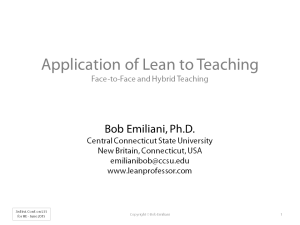The Third International Conference on Lean Six Sigma for Higher Education was held at Heriot-Watt University in Edinburgh, Scotland, on 8-9 June 2015. The theme of the conference was “Making Higher Education Institutions Efficient and Effective through Lean Six Sigma Deployment.”
The title of my keynote talk was: “Application of Lean to Teaching.” I discussed how I developed and applied the Lean teaching pedagogy over the last 15-plus years. In addition, I presented my new approach to course design aimed at transforming face-to-face and hybrid teaching from “push” to “pull. Click on the image below to view my presentation.
I also led a workshop titled: “Lean Leadership for Higher Education,” which presented how university leaders should begin a Lean transformation and gain broad-based buy-in. Both were very well received.

